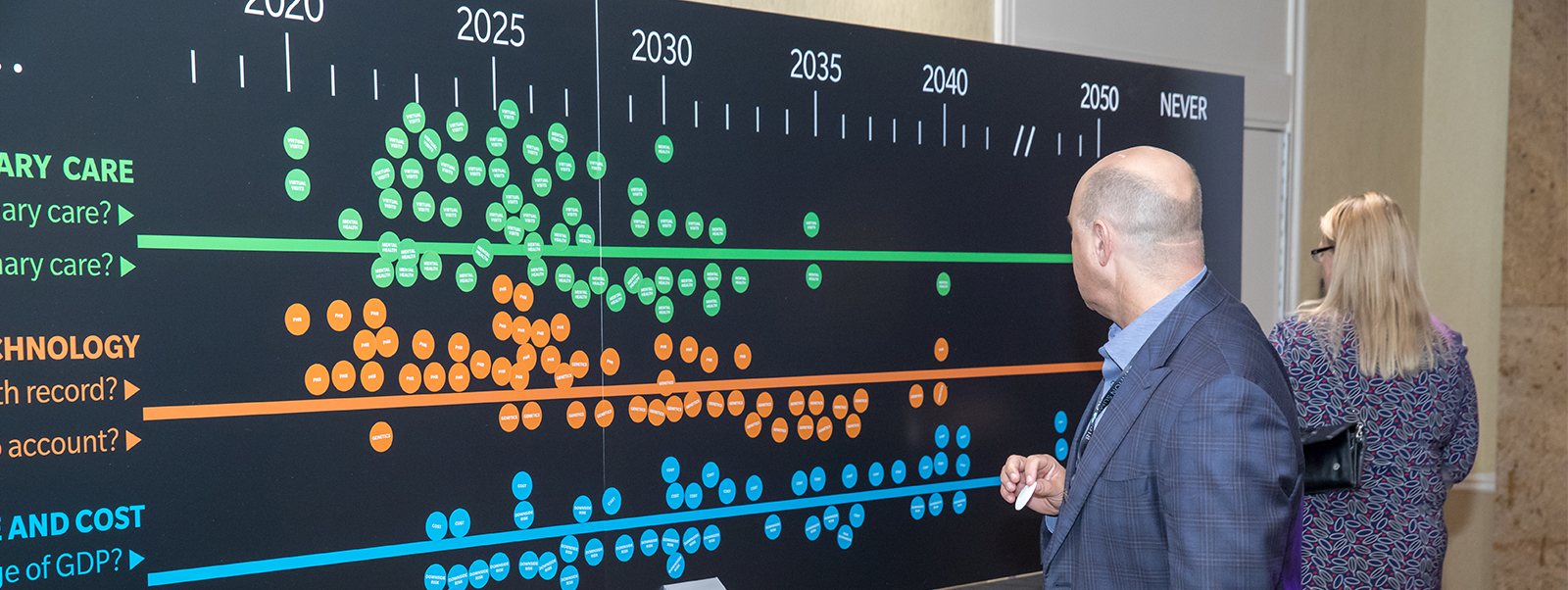Editor’s Note: The following research was conducted in real time at this year’s Oliver Wyman Health Innovation Summit, where we surveyed healthcare leaders and influencers to predict when healthcare’s next big wave of change will sweep the industry. For key takeaways from this year’s Summit, see our recaps of Day 1, Day 2, and Day 3.
Virtual visits might overtake physical primary care visits within the next two years. Personal health records might be in the hands of over 50 percent of consumers within five. Healthcare costs might just never decline as a percentage of gross domestic product (GDP).
These were some of the predictions from this year’s Oliver Wyman Health Innovation Summit. We asked over 350 senior healthcare executives for their best guesses on when we’ll reach some of the industry’s tipping points. Our goal: to crowdsource healthcare’s crystal ball. Biases aside, here’s a deeper dive into their predictions across primary care, healthcare technology, value, and cost:
Prediction 1: Primary Care is Up for Disruption
Most executives believe the number of virtual visits will surpass the number of physical visits by 2025. Ditto for the integration of mental health into primary care (although it’s perceived this shift is likely to be slower).
Healthcare must reinvent the mobile experience. Financial services did not put a banker on FaceTime. The sports industry did not just put a game on a screen. As we reach the tipping point, healthcare executives must consider the shift to virtual as going much deeper than just having a physician popping up on a video screen to check off a list of symptoms.
Fortunately, we’re already beginning to see the redefinition of care access. Teladoc Health lets consumers chat virtually with over 3,000 physicians in ten minutes or less – and also get a second opinion, manage their medical history, and send a prescription over to the pharmacy down the street. Meanwhile, Babylon Health enables virtual, real-time communication with both healthcare professionals and an artificial intelligence-powered chatbot that provides health and triage information. And Scanwell Health, a Food and Drug Adminstration-cleared urine testing mobile app, lets consumers diagnose a urinary tract infection in three minutes via their phones and a $10 test kit. These are just three examples of companies taking the virtual physician visit to the next level.
We also asked respondents to predict when they believe mental health will be consistently integrated into primary care. Most predict this to happen within the next five to ten years. Worthy of note? For the first time in the Summit’s history, mental health made it onto the main stage – a reflection of the importance of a growing epidemic within our system. Mental health conditions represent 4 percent of claims, yet they affect nearly 1 in 5 people across the United States. We spend too much money on mental health because we don’t spend enough money on mental health. As Oliver Wyman’s Health & Life Sciences Partner, Sam Glick, recently wrote in honor of World Mental Health Day for the World Economic Forum’s Global Agenda, it’s time we end our “separate but unequal” approach to mental health.
Prediction 2: Genetics...So Close, Yet So Far Away
We asked: “In what year will 50 percent of clinical decisions take genetics into account?” There was no clear consensus – answers ranged between 2021 and 2060.
Nearly two decades ago, Bill Clinton stated, “Genome science […] will revolutionize the diagnosis, prevention and treatment of most, if not all, human diseases.” Precision medicine’s potential has skyrocketed but much has been left untapped. With the top grossing drugs in the US benefiting less than 25 percent of those who take them, we know there is significant value in moving forward.
"If research doesn’t become more holistic, we won’t get to the point where we can personalize care for an individual at any given moment in time," said Eric Dishman, Director, All of Us Research Program, National Institutes of Health, at the Summit.
The verdict is still out as to when genomics will shake up the status quo.
Prediction 3: Value and Cost are Big Uncertainties
Will healthcare costs ever decrease relative to GDP? TBD.
The number of executives who surmise healthcare costs will never decline as a percentage of GDP is the same as the number of executives who believe costs might decline sometime in the next decade. With health spending expected to represent almost 20 percent of the GDP by 2026, we must ask: Will data liberation, the redefinition of "health", and the shift to value, help bend the cost curve? Organizations must be rewired and processes re-invented if we are to truly impact costs.
The inclusion of downside risk is coming, albeit slowly. Most healthcare executives believe 50 percent of provider payments will include downside risk by 2030. Despite CMS’ goal to have 90 percent of Medicare payments tied to value by 2019, the inclusion of down-side risk has been slower than expected. One of the main challenges? Interoperability.
But we don’t expect that “obstacle” to hold for much longer. MyHealthEData, Blue Button 2.0, new electronic health record incentive programs, and a health information technology industry convergence on emerging internet standards, for instance, are all paving the way for free data flow.
As we overheard Niyum Gandhi, Chief Population Health Officer at Mount Sinai Health System, say during a Summit roundtable discussion with Aneesh Chopra, President of CareJourney, and former US Chief Technology Officer, “The cost to turn on the FHIR API is 0 so … the ROI is infinite.”
Fundamental arguments aside, the value to payers, providers, health information technologists, and innovators is clear. If nothing else, as data flows freely between systems, so will the potential to accelerate value-based payments.
One thing the survey made clear: change is on the way, and some change is right around the corner. The market is primed for much of this disruption. As boundaries continue to blur and new roles emerge, now is a better time than ever before to join the revolution.




